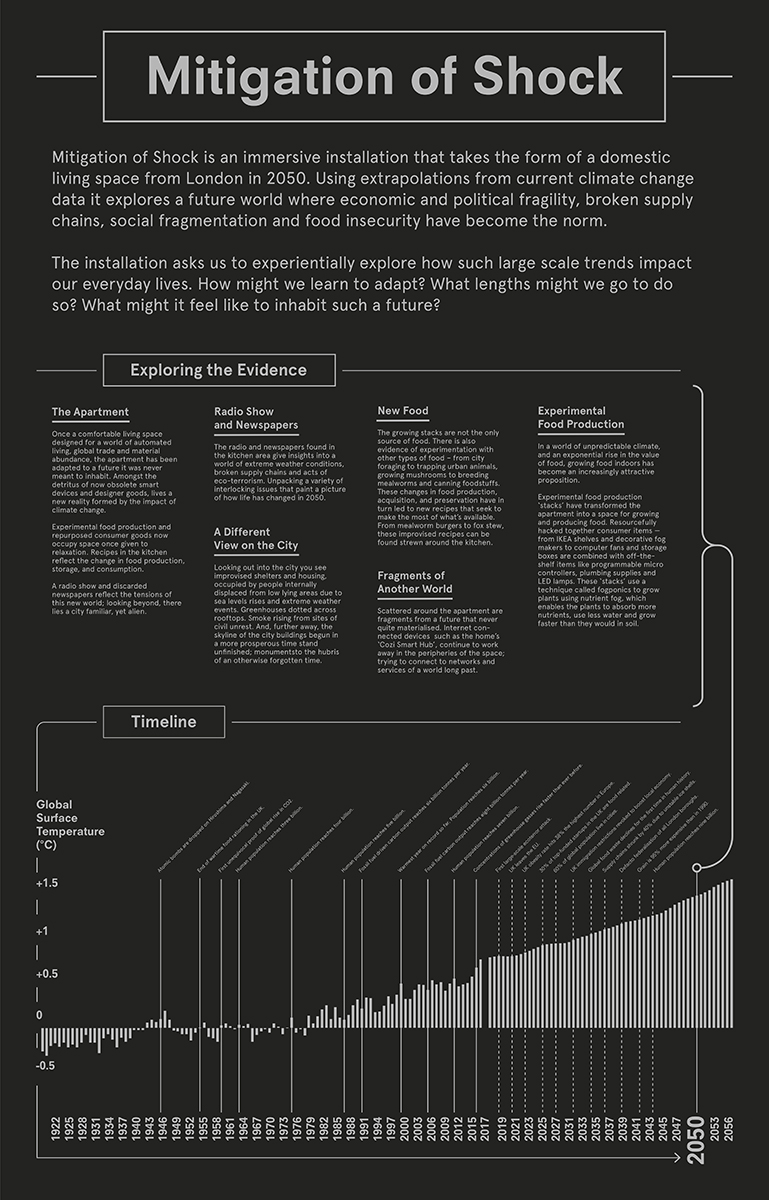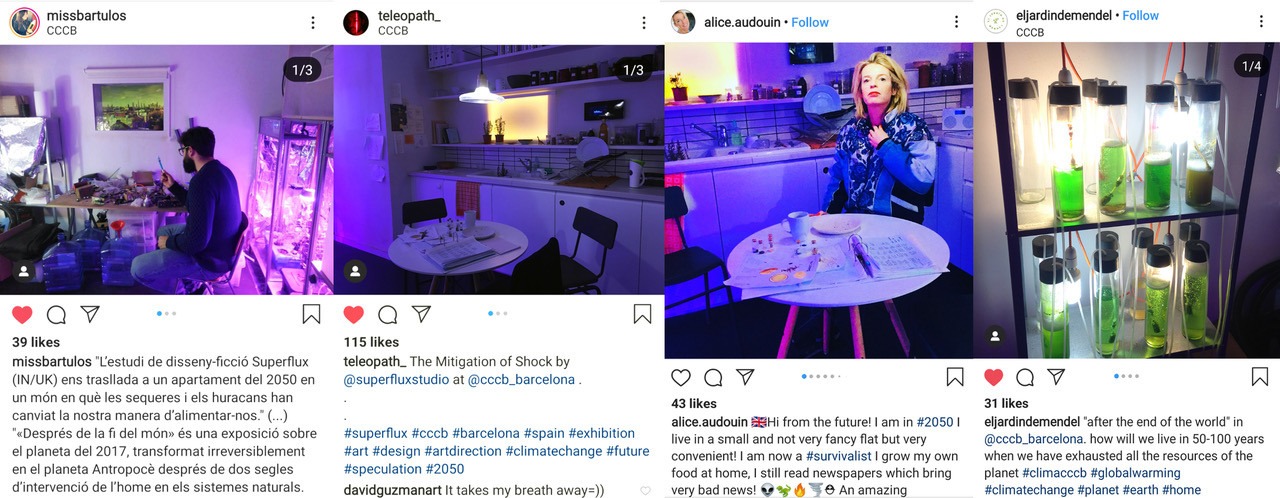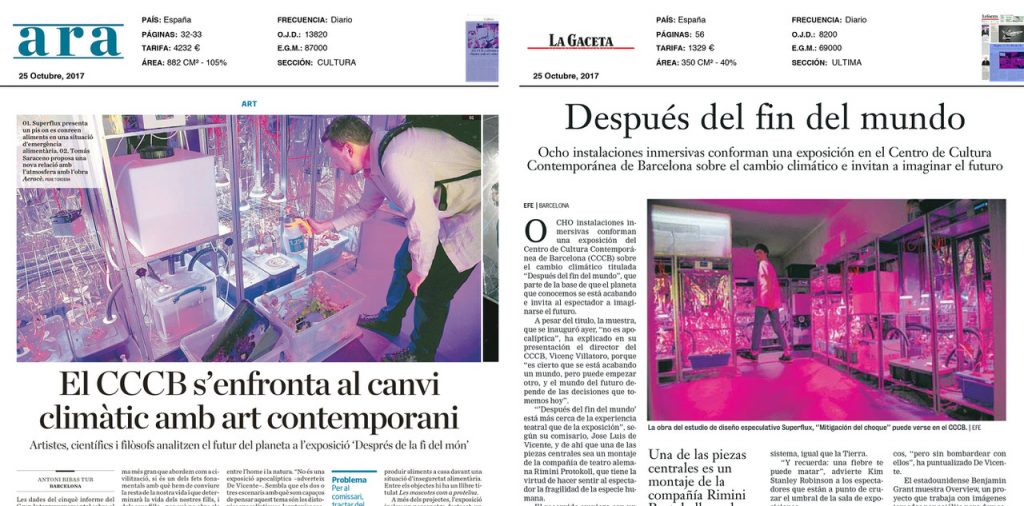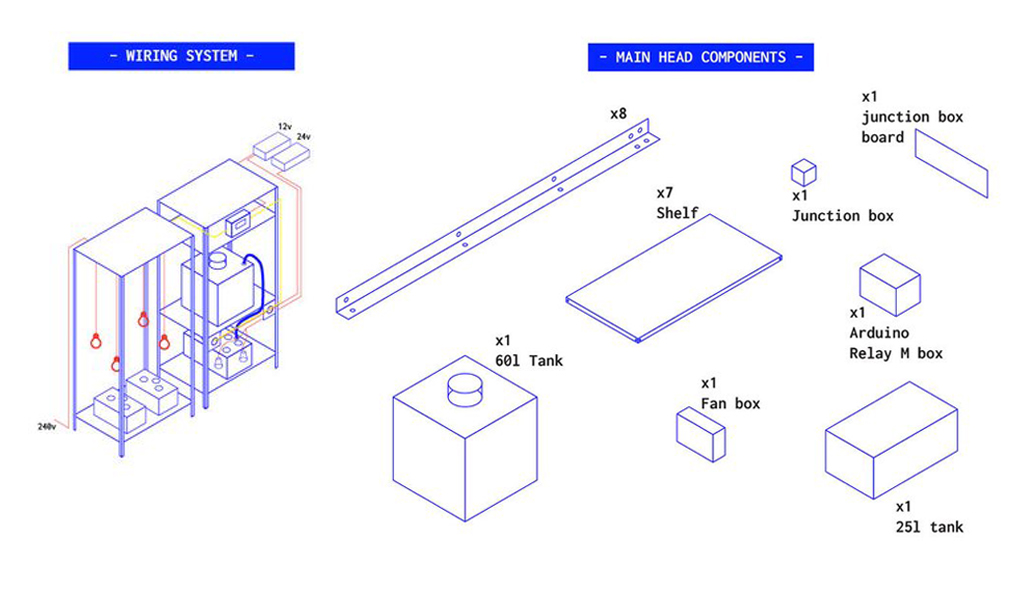Projects
Mitigation of Shock (London)
A pragmatic experiment practicing hope for a future disrupted by climate change.
Take a tour around a future London apartment radically adapted for living with the consequences of climate change. One of the inhabitants shares their personal experience of adjusting to a world transformed by food insecurity and climate extremities at home, and in their local community.
This installation ‘Mitigation of Shock’ was conceived by Superflux and first presented at the Centre for Contemporary Culture (CCCB) Barcelona.
Read on to learn more about the project, the research, the food computers, and the immersive installation.
CONTEXT
THE INSTALLATION
REACTIONS
MOTIVATION
PROCESS
ACKNOWLEDGEMENTS
CONTEXT
Climate projections show that within the next few decades the U.K and Northern Europe are very likely to experience huge problems with food insecurity, extreme weather, and resource scarcity. Yet with data and projections alone, it is difficult to imagine how these consequences of climate change will alter our lived experiences. As they go about the drudgery of daily life, we have found that most people are at a loss as to how to translate the intangible data strewn across climate graphs and charts into tangible, sustainable action. For a complex phenomenon like climate change, philosopher Timothy Morton uses the term hyperobject: something with spatial and temporal properties beyond the cognitive and theoretical grasp of the human mind.
Mitigation of Shock (London, 2050) is our attempt to make the size and complexity of a hyperobject like climate change tangible, relatable and specific. Following extensive research and prototyping, as well as interviews with experts from NASA, the UK Met Office and Forum for the Future, we built an entire future apartment situated in the context of climate change and its consequences on food security. People could step inside this family home and directly experience for themselves what the restrictions of this future might feel like. Instead of leaving visitors scared and unprepared by the challenges of this world, we shared methods and tools for not only surviving, but thriving there.
Mitigation of Shock first appeared as an immersive installation in the show ‘After the End of the World’ at CCCB in 2017-18. The future home merges the macabre and the mundane as the social and economic consequences of climate change infiltrate the domestic space. More than fictional possibility, MOS is intended to kindle a sense of actionable hope by introducing a functioning network of tools hacked together from existing resources.
MITIGATION OF SHOCK: THE INSTALLATION
The installation transports visitors into a London flat, around 2050 or so, when Jon and Anab’s son might be their age today. A time that feels very far away, but very close when considered from a multigenerational perspective.
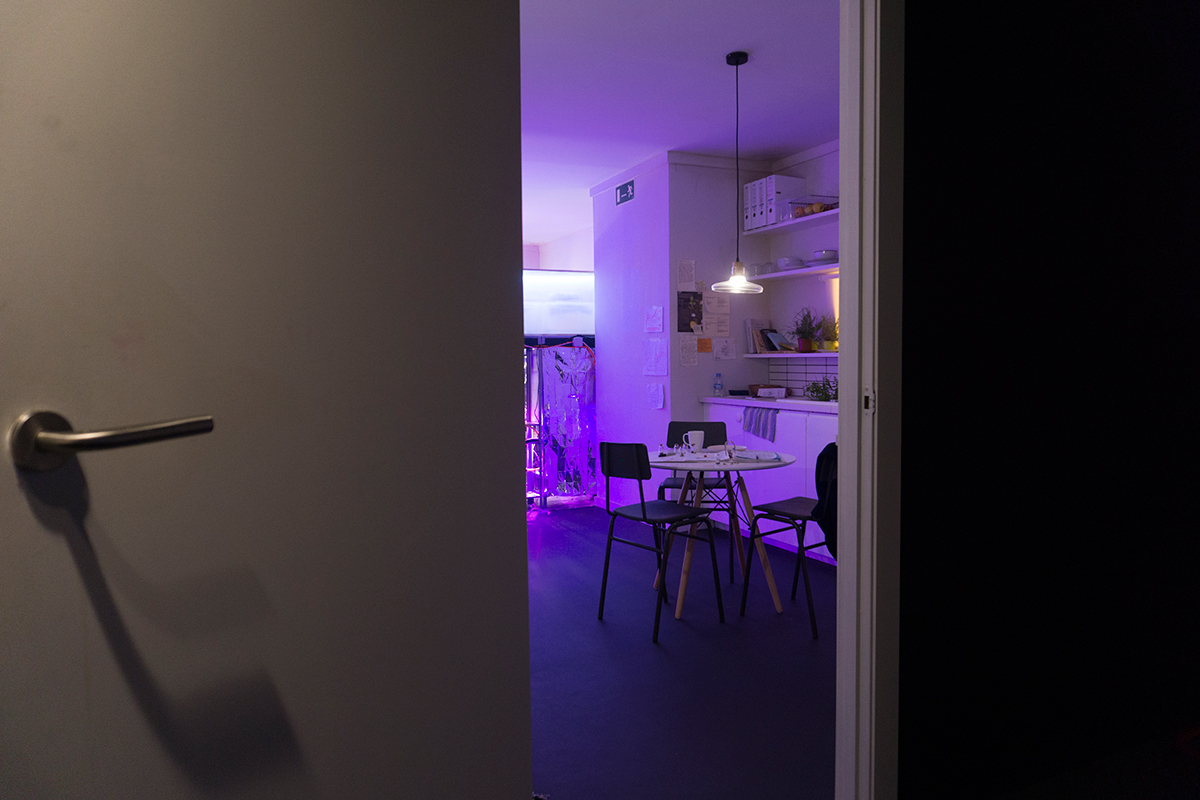
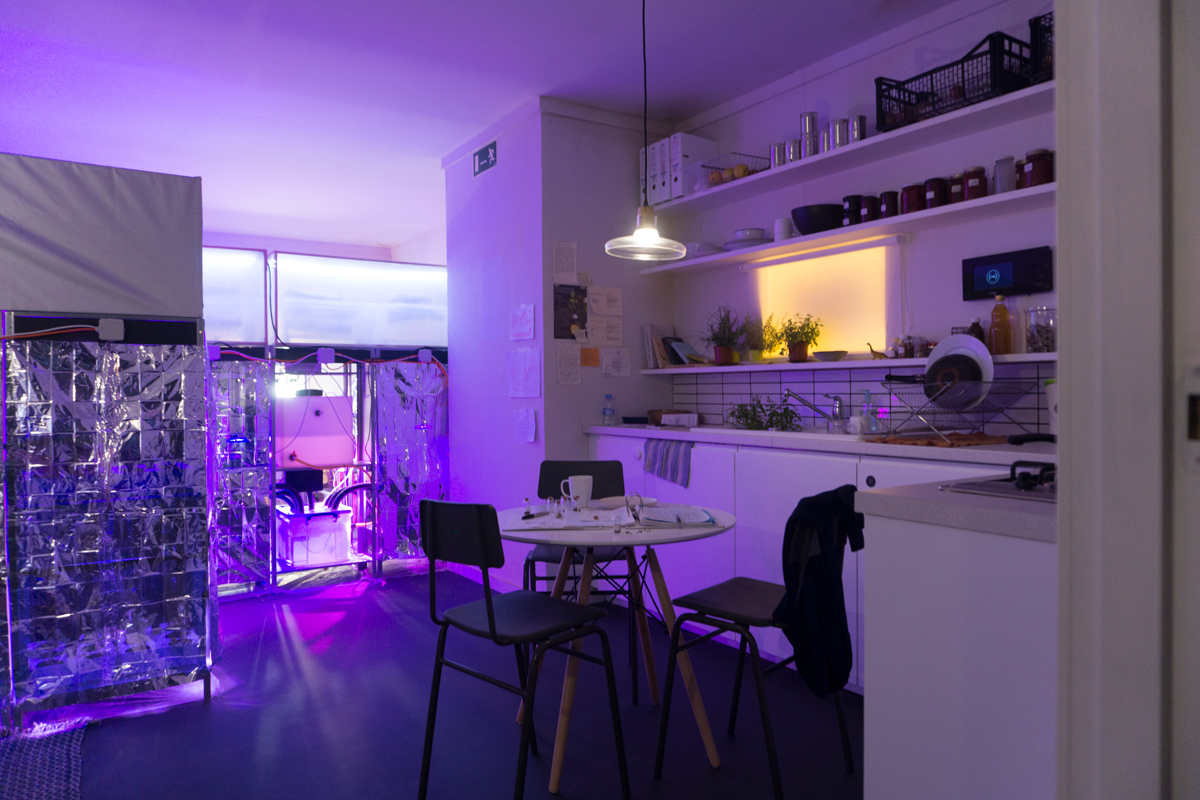
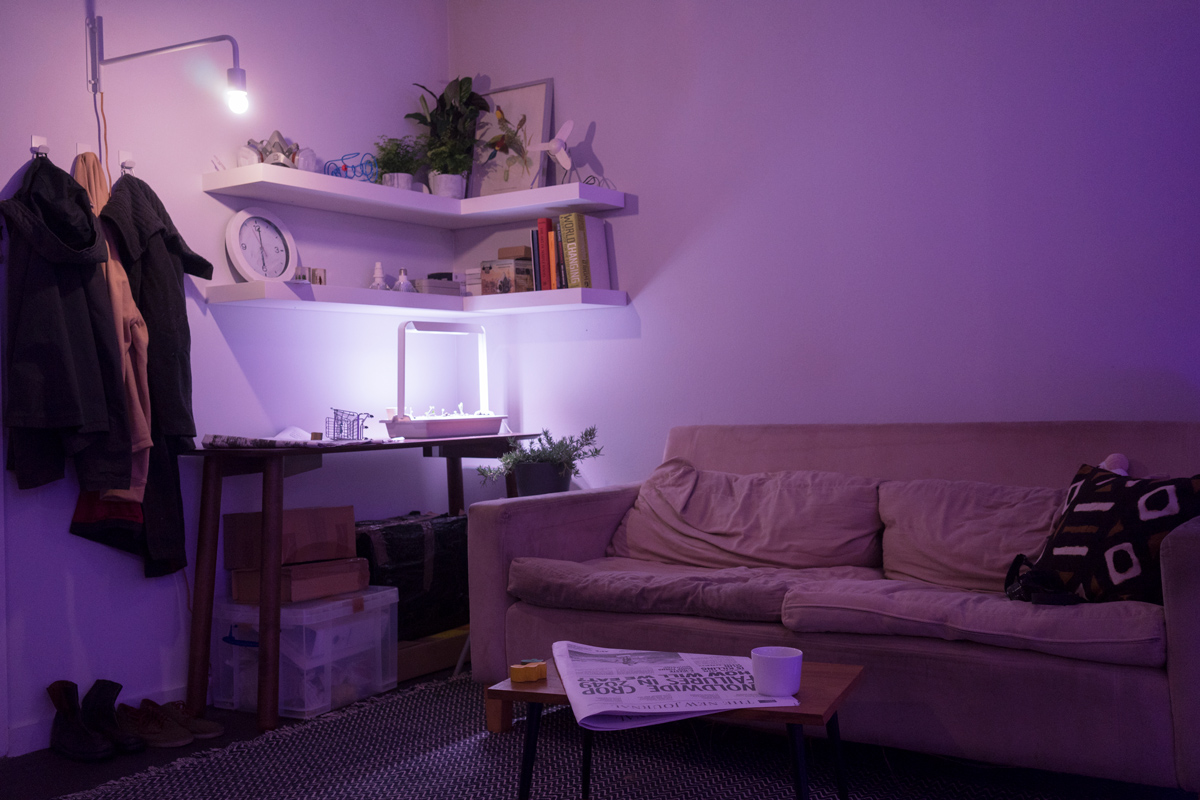
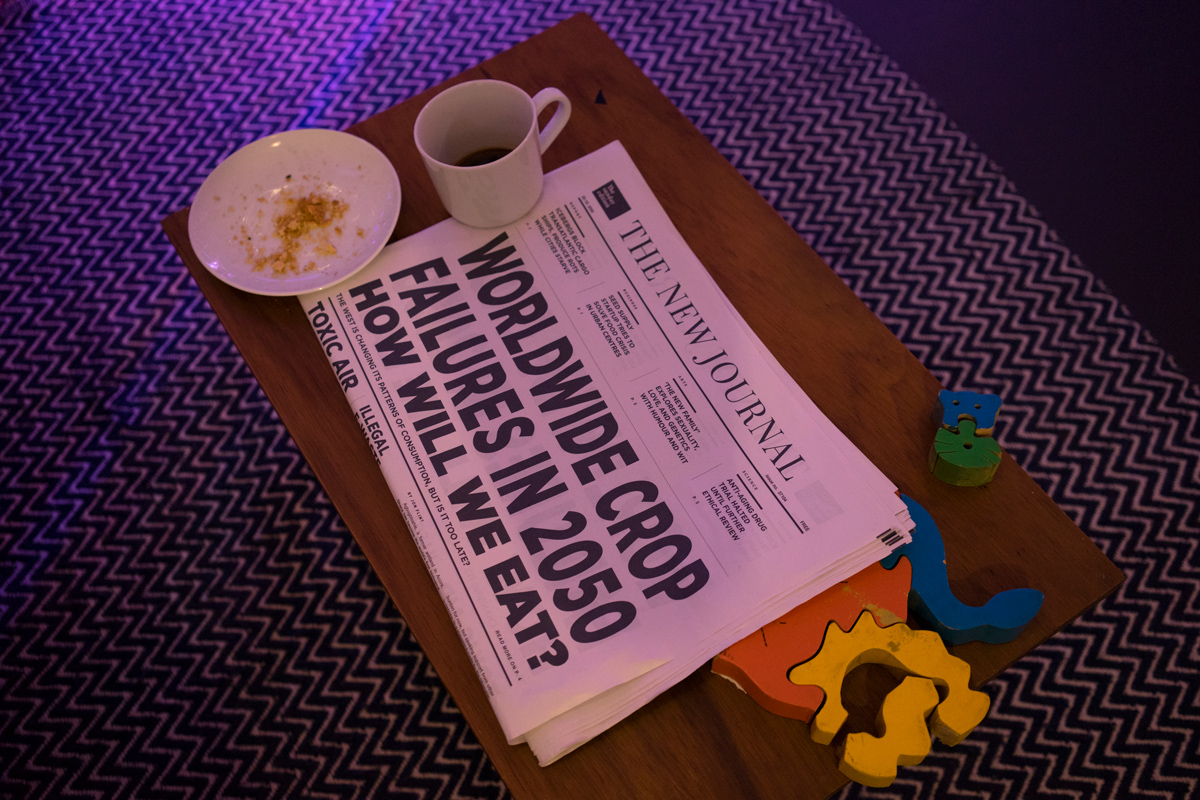
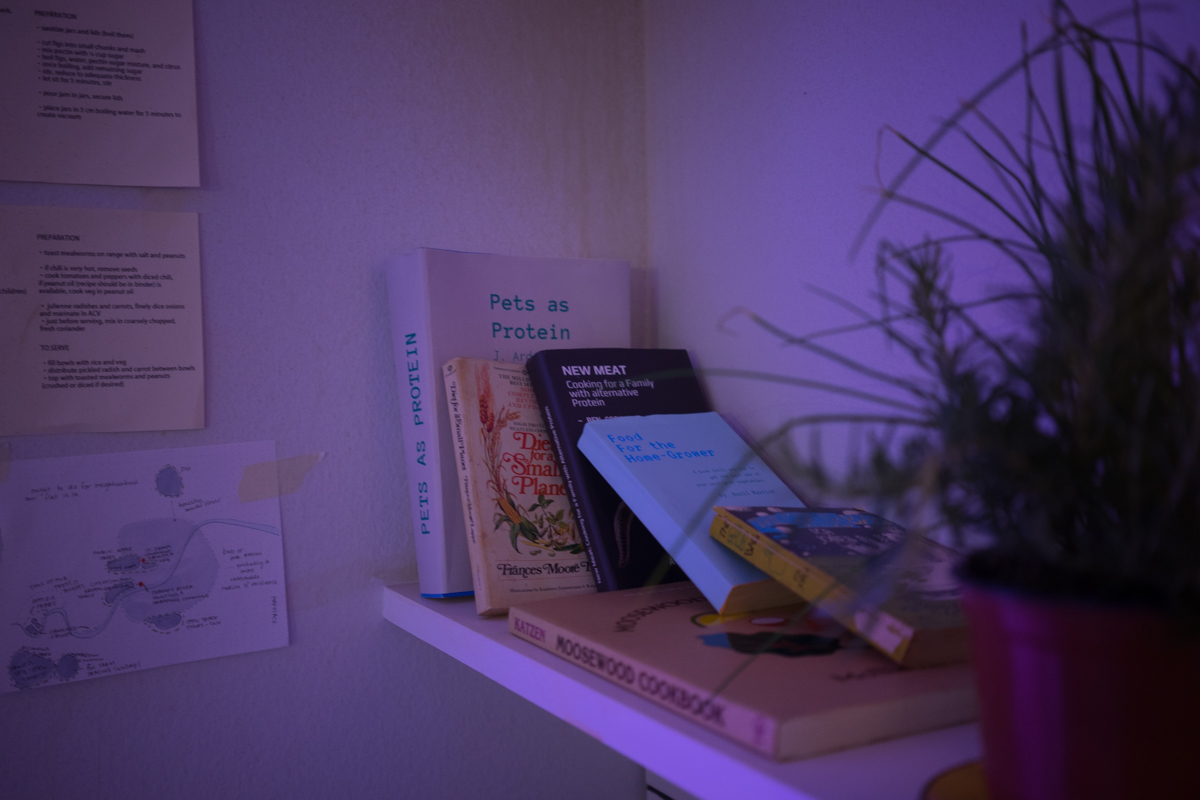
Once a comfortable living space designed for a world of automated living, global trade and material abundance, the apartment has been adapted to a future it was never meant to inhabit. Discarded newspapers and a radio show reflect the tensions of this new world; recipes in the kitchen reveal the change in food production, storage, and consumption. Scattered around the apartment are fragments from a future that never quite materialised.
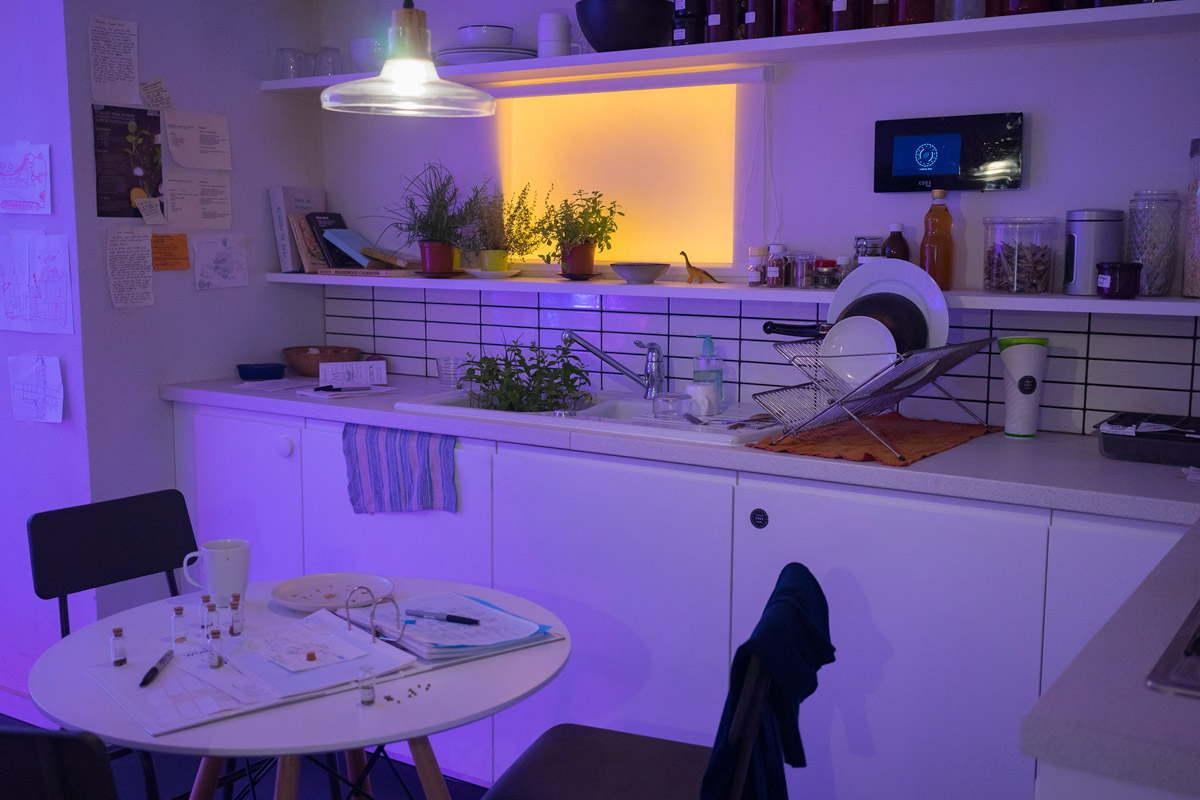

Internet connected devices such as the home’s ‘Cozi Smart Hub’, continue to work away in the peripheries of the space; trying to connect to networks and services of a world long past. Experimental food production stacks occupy the space once given to relaxation—transforming the apartment into a space for growing and producing food supplies. Food computers have been improvised from the detritus of a technological utopia that never quite arrived.

Food computers monitor humidity and temperature.
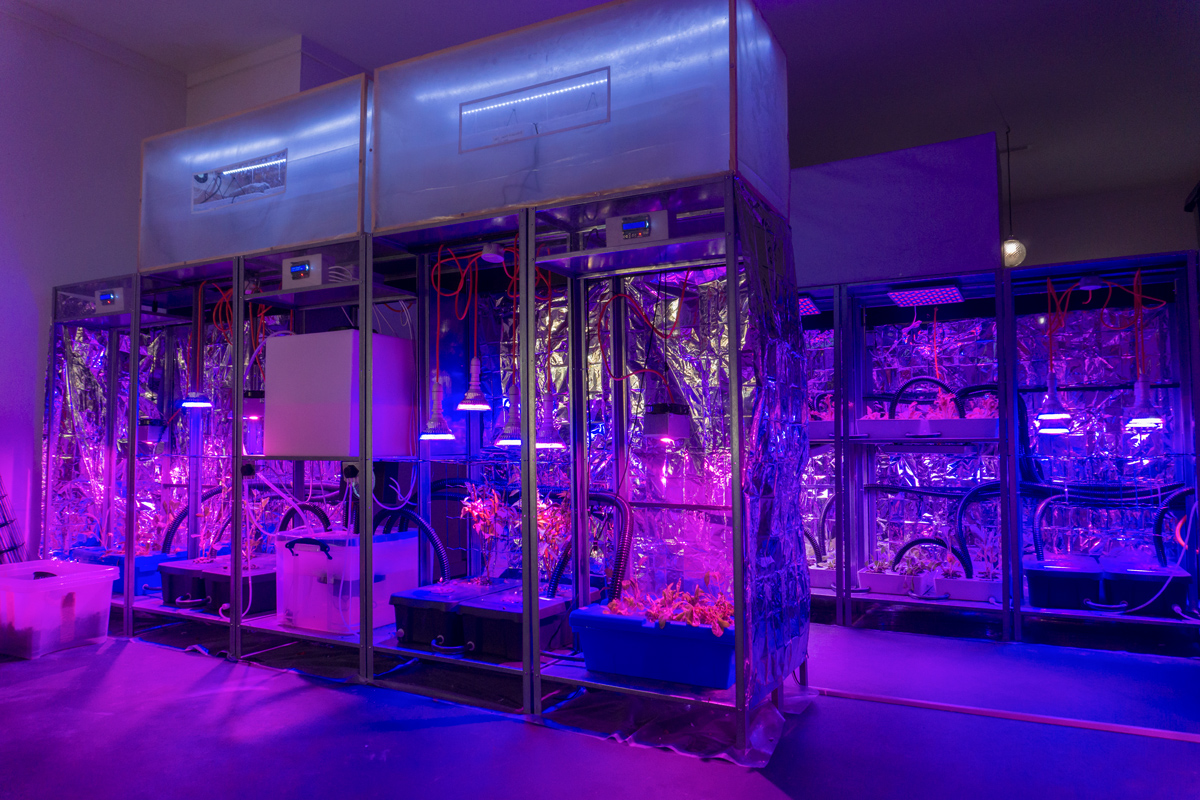


Resourcefully hacked together consumer items – from IKEA shelves and decorative fog makers to computer fans and storage boxes are combined with off-the-shelf items like programmable microcontrollers, plumbing supplies and LED lamps to create improvised food computer stacks. The ‘stacks’ use a technique called fogponics to grow plants using nutrient fog. This fog enables the plants to absorb more nutrients, use less water and grow faster than they would in soil.

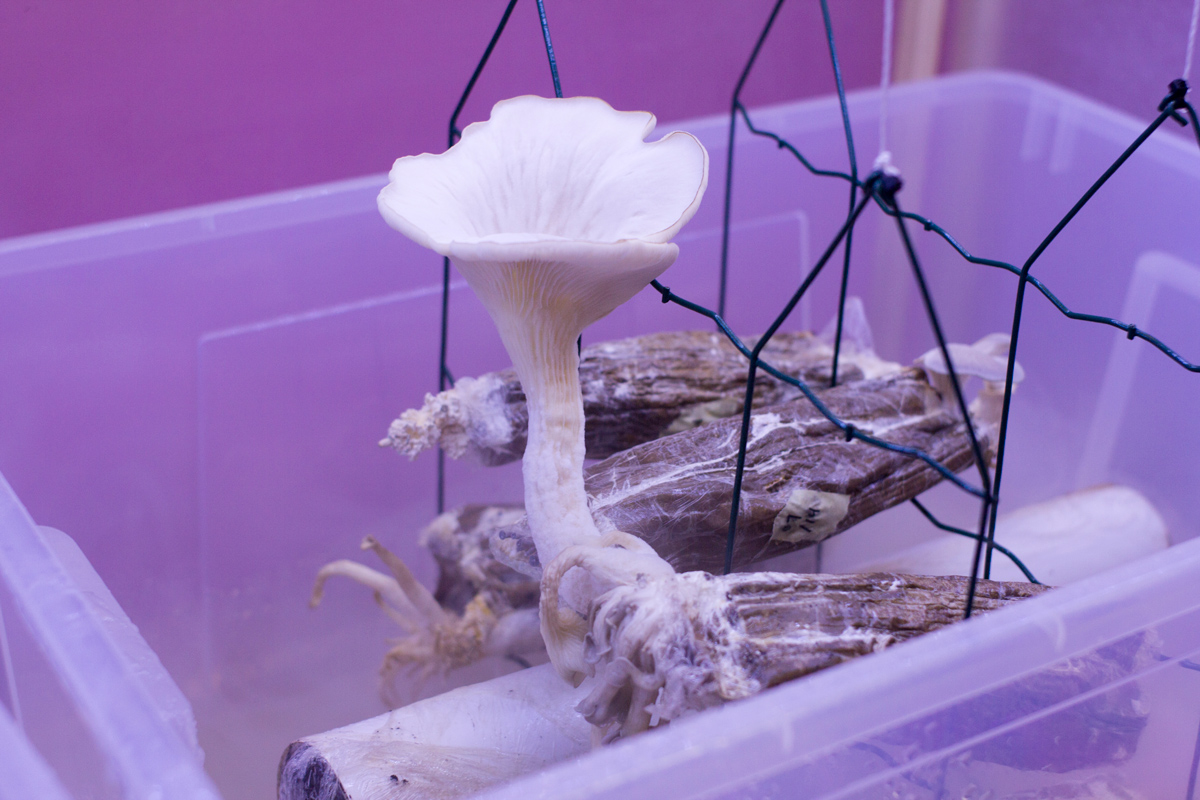 Towering silver stacks of mushrooms, cabbages and chilli plants flourish in an optimally lit indoor environment. Fog oozes from the contraptions; purple light blinds anyone looking too closely; water pipes drone noisily; animal snares and the skins of unfortunate foxes clutter the space while mycelium bears fruit in the blasted ruins of capitalism.
Towering silver stacks of mushrooms, cabbages and chilli plants flourish in an optimally lit indoor environment. Fog oozes from the contraptions; purple light blinds anyone looking too closely; water pipes drone noisily; animal snares and the skins of unfortunate foxes clutter the space while mycelium bears fruit in the blasted ruins of capitalism.
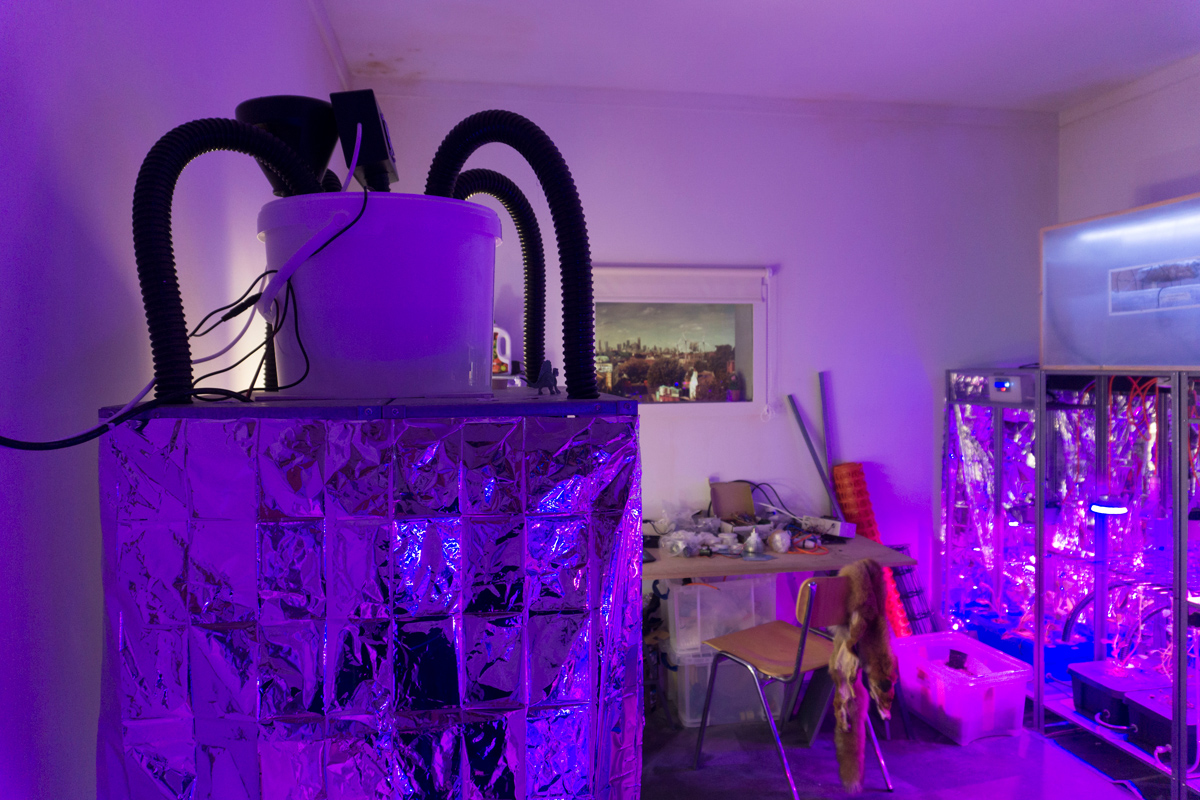
The growing stacks are not the only source of food. Around the apartment is littered evidence of experimentation with other types of food; city foraging, trapping urban animals, growing mushrooms, breeding mealworms and canning foodstuffs. These changes in food production, acquisition, and preservation have led to the development of new recipes that seek to make the most of available food. Improvised recipes for dishes including mealworm burgers and fox stew can be found strewn around the kitchen.
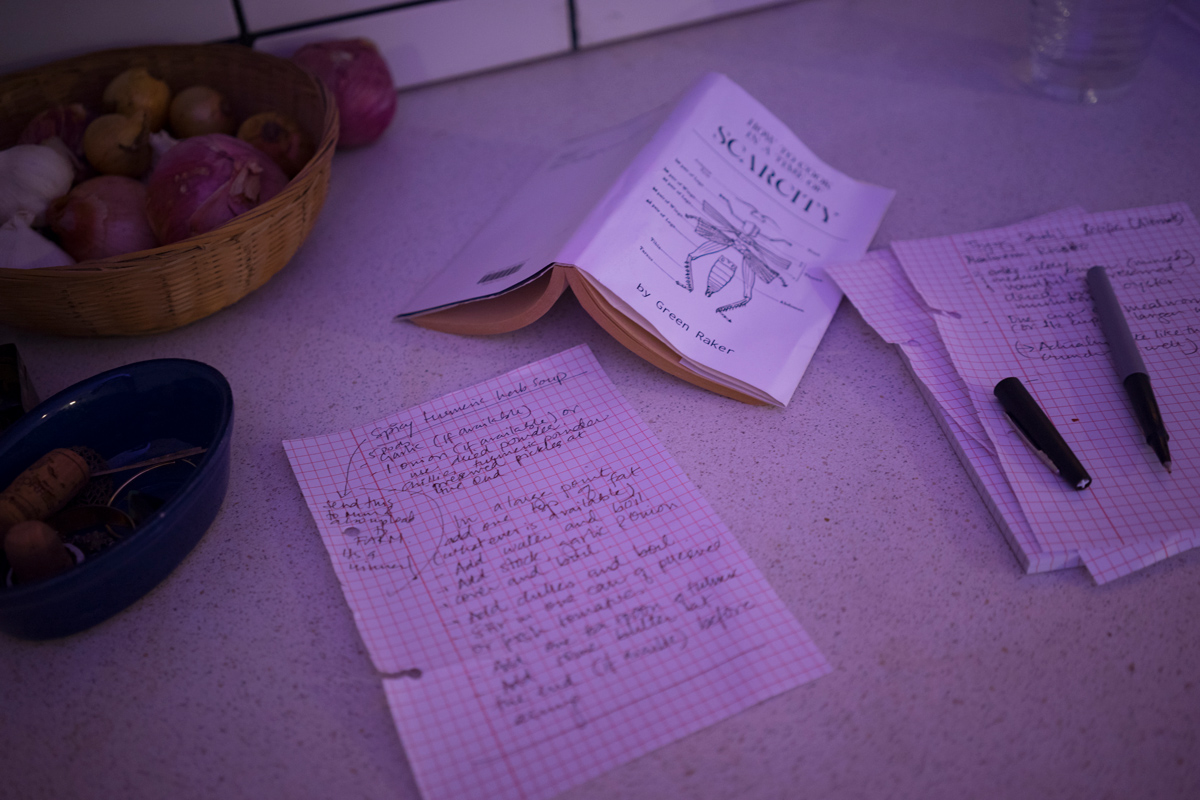
Local networks of barter and trade have grown in the space once filled by global capital. Self-selected networks of trust and cooperation compete with the rule of law. Self-reliance and ingenuity fill the void left by the collapse of the paradigm of consumption. All at once somewhat alien, yet strangely familiar, the space gives a rich experiential insight into some of the challenges we could all soon face, and the tactics and strategies we might employ to mitigate and overcome them.
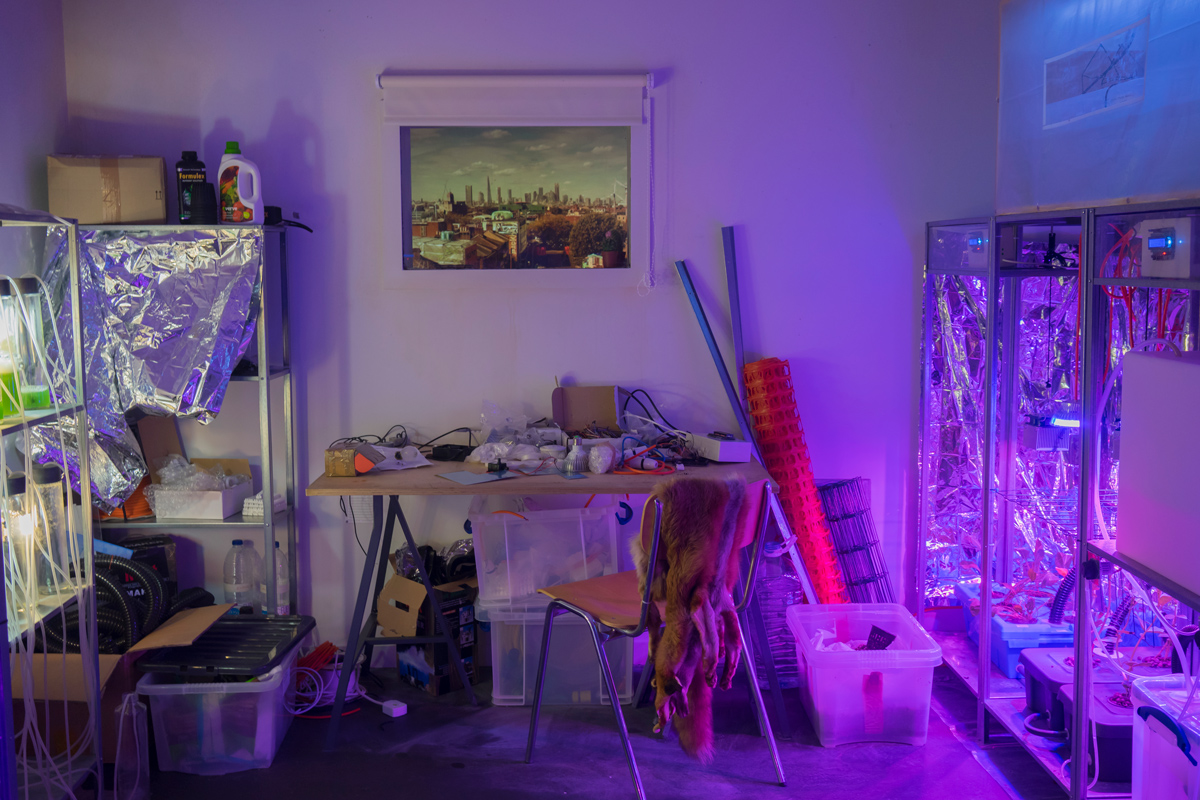
Outside the window you can see improvised shelters and housing occupied by people internally displaced from low lying areas following sea levels rises and extreme weather events. Greenhouses are dotted across the rooftops. Smoke rises from sites of civil unrest. Further away, the skyline of city developments whose construction began in a more prosperous time stand unfinished; monuments to the hubris of an otherwise forgotten time.
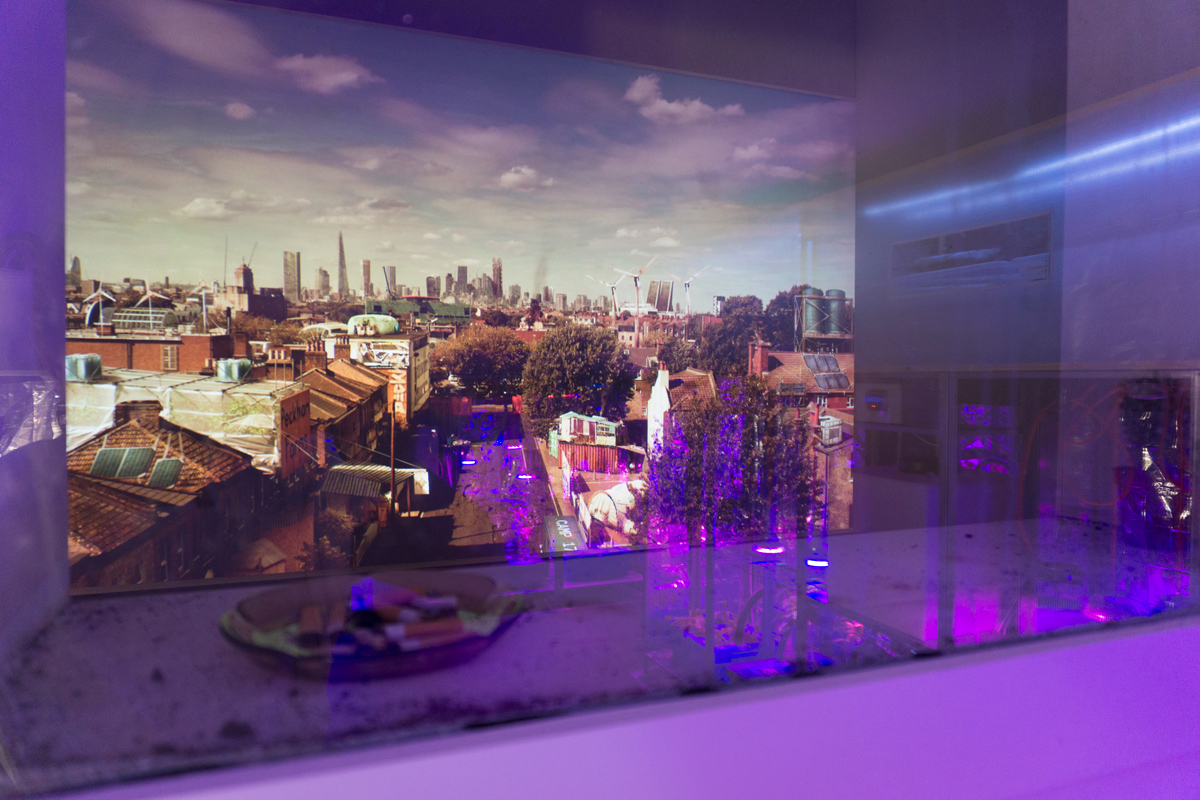
Unexpected changes to the skyline from the apartment window

The installation brings the visitor face to face – directly, emotionally, intellectually – with the future of climate instability, food insecurity, economic and political fragility, and social fragmentation.
The experience asks us to experientially explore how such large scale trends impact our everyday lives.
How might we learn to adapt?
What lengths might we go to do so?
What might it feel like to inhabit such a future?
The work explores how our lifestyles and domestic spaces might soon change to adapt to life in a world of insecurities around food availability and disruptions to our current consumption habits.
If you would like to find out more about the motivation behind Mitigation of Shock, our research process and reactions to the installation, please keep reading on.
WHAT WERE THE REACTIONS?
“Mitigation of Shock will become a reference piece in the coming years, as the art world catches up with the physical universe. (only gripe is 2050 seems a bit.. generous) Congrats @anabjain et al (TY @thesjef)” — Julian Oliver (@julian0liver)
“An unsettling peek into the reality of life in 2050” — TED Ideas
“Mitigation of Shock is a triumph. It’s amongst your best work, I think. There’s so much love in that room.” — Honor Harger, Executive Director, Arts Science Museum, Singapore
INSTRUCTABLES
We are starting put up the recipes for how to build these food stacks on Instructables and hoping to share much more widely.

WHAT WAS OUR MOTIVATION FOR DOING THIS?
Mitigation of Shock is not a prediction, nor a render.
Our approach combining foresight with practical experimentation makes it possible to directly step into a familiar space to confront our fears and find concrete ways to mitigate the shock of climate change. This space is an invitation for others to enter, to make climate change tangible for those fortunate enough to currently be unaffected by it. When people walk in, we wanted them to feel a sense of strange familiarity in this completely transformed space. We wanted people to emotionally connect with the challenges everyone could soon be facing. We wanted to help prepare for a future, by working with it today. This experience is intended to nurture hope and motivate transformative action. At the same time, it raises awareness and a sense of responsibility around the consequences of inaction.
We chose 2050 for two reasons. Firstly, because it sits within many current and well respected climate models. Secondly – and perhaps more significantly – by 2050 many of today’s children will be their parents age. This fosters an emotional, as well as intellectual, connection to this near future world.
By focusing on a residential space in an urban environment in the Global North, we were able to communicate with demographics who have the capacity to minimise climate change by changing their current patterns of consumption and who might assume they won’t personally be impacted by the effects of climate change.
We also want to acknowledge here that no future will be marked exclusively by the impact of climate change. Coexistent trends and forces will be simultaneously working to shape any world we find ourselves in. Whilst the project is based on gaining better understanding of the ground level implications of global warming, it also acknowledges coexistent trends and forces such as infrastructure, transport, energy, water, housing, individual tech savviness, autonomy and agency of communities, amongst others. The ensemble of these core influences skilfully manifests within the finest details of the space, pointing out the complexity of the projected future world and the interdependencies between various game-changing factors.
It is this concept of interdependence that ultimately led us to the final outcome. Over the course of the project, we realised how important it was to explore our deeply entangled relationships with other species and non-human entities. To explore what it would mean to design not simply “tools” that do our bidding, but to design with a more-than-human approach; to design as co-inhabitants of the same complex, ecological system in which humans and non-human species co-exist. A reminder that we don’t exist in isolation. We never have. But now we are entering a time where we can no longer live in the illusion of isolation, we can either embrace this new understanding and work with its implications or face the hubris of our inaction.
As practitioners this meant another level of speculative commitment altogether. The project gave birth to new, interspecies relationships. We moved from just making things, to making things that grow. Of course foresters grow trees, and farmers grow wheat – but within our world of design the focus on the ‘product or artefact’ has always been the embodiment of an outcome. Here, instead we began to focus on the organism rather than the artefact. By suspending pots with seeds in basins of nutrient fog, we saw roots being born; growing into delicate ecologies; transforming; dying; and re-emerged anew incessantly. This direct engagement with these living entities, drew us into the world of many interacting species. It provided a useful vantage point for knowing ourselves as participants in more complex human and non human relationships.
As Anne Galloway writes:
Complementary ways of thinking, doing, and making emphasise the practice of care and imagination—and challenge us to work with, not against, vulnerability, humility and interdependence.
Scholar Katherine Hayles also describes our current condition eloquently:
“As we move deeper into a highly technological regime and as the technological infrastructure surrounding us becomes more and more complex, it becomes increasingly obvious that human agency cannot ever be seen in isolation from the systems with which humans are in constant and constitutive interaction.”
We at Superflux conclude with a call to arms; a call to closely consider our relationships (both human and non-human) with the world within which we live and work. A call to consider ourselves in relationship with, not as masters of, the deeper ecology around and within us. And to embody this in our actions.
A GLIMPSE OF OUR RESEARCH PROCESS

Initial testing of basic IKEA grow kit.

A variety of plants grown with the basic IKEA grow kit.

First experiments in growing crickets as a potential protein source.

First experiment using Fogponics and compact fluorescent bulbs to grow tomatoes.

Initial experiments growing mushrooms on cardboard and coffee grounds.

First prototype of hydroponics growing system.

Initial experiments using Arduinos to control a growing system.

Prototype grow lamp built in the studio.

First prototype living space with growing systems at Somerset House, London

Inspecting the root system of a chilli plant grown using a prototype Fogponics system.

Checking fog levels in a prototype Fogponics system.

Trial setup of the space.

Development of an app that can control the Fogponics growing system.
ACKNOWLEDGEMENTS
We would like to thank Kristin Dunlop and her team at Suncorp (now Climate KIC) for supporting the initial research and development work, José Luis de Vicente for commissioning this project for the After The End of the World show, Miquel Nogués, Susana Garcia and the team at CCCB for being incredibly supportive throughout the entire duration of the show, Prof. Deb Chachra for her insights and collaboration and Somerset House Studios for their support during the project development.
We are continuing to develop this work further, exploring new, more sustainable food growing systems, and would love to hear from people who might be interested in becoming collaborators, partners or commissioners.
